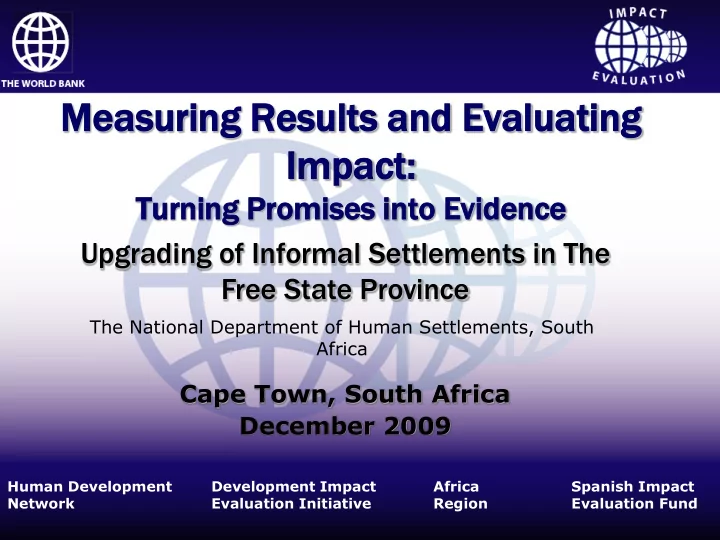

Measur suring ing Result lts s and nd Evalu luating ating Impa pact: t: Turn rnin ing g Promise ises s in into Evid idence ence Upgrading of Informal Settlements in The Free State Province The National Department of Human Settlements, South Africa Cape Town, South Africa December 2009 Human Development Development Impact Africa Spanish Impact Network Evaluation Initiative Region Evaluation Fund
1. Background Phase 2: People already have houses and the department of human settlements plans to provide sanitation services to 500 households in phase 2. There are a total of 3000 houses in phase 2 and 3000 in phase 3 (total of 6,000 houses) but there are limited funds. Evaluation unit suggests that a lottery be done to determine the streets that will receive services, (this will be discussed with the province and municipalities’ implementation unit. Consultation process will be with the contractor(s) as well.) 2
2. Results Chain Inputs Activities Outputs Outcomes Long term Outcomes • …Water • Engagement • …Access to • Decrease in • … and with relevant water and incidents of Improved sanitation stakeholders sanitation diarrhea health • Provision of • Improved infrastructure socio economic indicators • Decrease stunting and wasting • Decrease prevalence of anemia 3
3. Primary Research Questions Evaluation Questions What is the impact of providing flushing toilets and running water (sanitation) to people with houses. Area of research: Phase 2 Grassland housing project in Free State. 4
5. Methodology Difference in Differences methodology. E.g. Comparing prevalence of diarrhea of the treatment and control groups before and after intervention. 5
4. Outcome Indicators Decrease in incidents of diarrhea Improved socio economic indicators e.g vegetable gardens; home based enterprises Decrease prevalence of stunting and wasting Decrease prevalence of anemia 6
6. Sample and data Sample size = 300, 10% of the population 50% treatment & 50% control (preliminary estimates) Sampling design: Random sampling of the predefined control and treatment groups in phase 2. This will be targeted in accordance with the province’s plans 7
7. Time Frame/Work Plan Consultations: Jan – Feb 2010 Baseline data collection and analysis: Mar- April 2010 Installation of services (intervention): June 2010 Post intervention data collection: June 2011. 8
8. Sources of Financing National Department of Human Settlements for the evaluation. 9
Di Diss ssem eminat ination ion TARGET AUDIENCE Internal: DHS; FSDHS; LPDHS; GPDHS (Operational people; MINTOP; STRATMAN; MINMEC); Housing institutions External (GoV): DoH, Water affairs, Safety and Security, Education, Transport, Ministry of M &E, Planning commission External (non-gov): NGOs, CBOs, The community PURPOSE: BUILD CONSENSUS Modalities: Report (DHS, WB, FS); Submissions (STRATMAN, MINMEC); Workshops (Stakeholders); Publication
PROCESS STEPS Draft Baseline Report March 10 Limpopo Free State DHS MINTOP & Prospective STRATMAN Feb-March plans April June Gauteng Stakeholders Workshops April/May
Lessons learned from the workshop Piloting Piloting must be done by the Department officials During piloting the interview may take longer than when administering the actual interview Put text boxes on each page of questionnaire and record time after completion of each page Weekends are more preferred for interviews as many people will be there Piloting is likely to lead to a need to change some issues in the questionnaire e.g. wording, order of questions Field testing must be done with few enumerators Training Three elements of training: plenary: lecture/ classroom style Exercise: interviewers interviewing each other Field work: very important to insist on it before the full study
Data quality management Supervision and survey mechanics Proposal: 15 teams for data collection, at the ratio of 1:4 (supervisor and interviewers) Prepare a list of households to be visited to record non responses At most 10% of non response should be an acceptable Management of non responses is critical. Adding sample size will not address the problem Revisit households to verify if they were interviewed (Households to be revisited should not be less than 15% and be selected randomly, establish protocol of and indicate things to be verified) The supervisor can visually observe the interviewer but it is not advisable Data collection date should be entered as well as data entry date Data entry: Interviewers to submit data on a weekly basis and can be analysed as it comes to assess the quality of the study Data entry programme should: Do rain checks e.g. gender Consistency of the skips
Sampling Opinion: The 6000 sample too big, could improve non-sampling error by decreasing sample size Big sample will have cost implications on the study Opinion on listing: this may be too costly to do census, but it may also lead to selection bias if not done on the whole population of interest Proposal for sampling: cartographic sampling
Recommend
More recommend